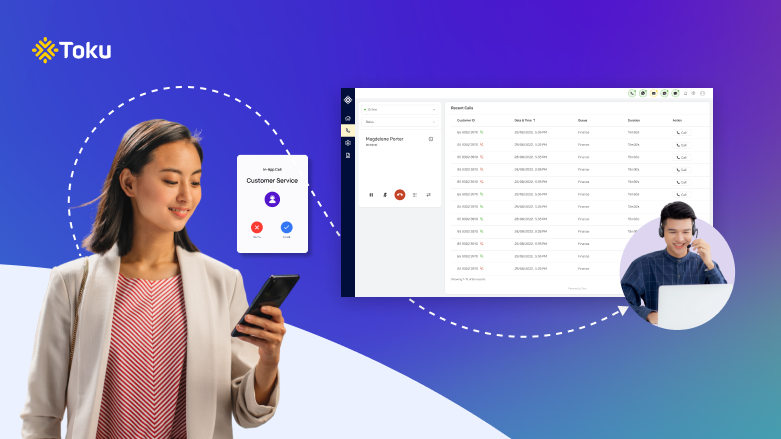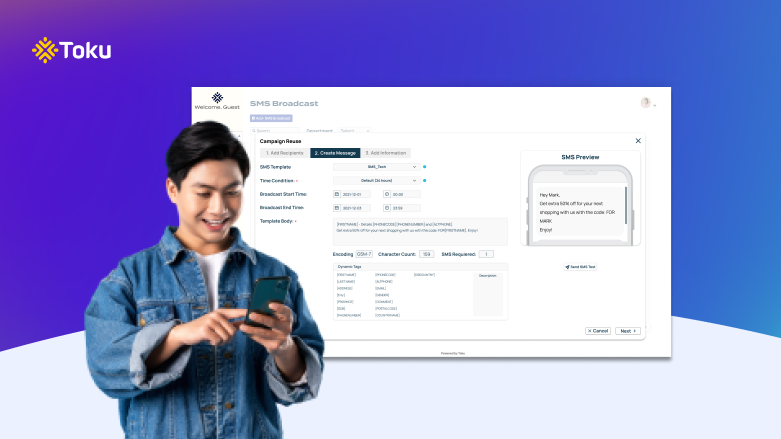Virtual numbers can transform how businesses of all sizes can engage with customers and partners while influencing their professional image.
In today’s rapidly evolving retail landscape, customers increasingly seek personalised experiences when they shop. Personalised retail experiences refer to tailored interactions that meet the specific needs and preferences of individual customers, creating a sense of connection and loyalty.
With the rise of e-commerce and the pandemic-induced shift towards digital channels, retailers are facing new challenges in delivering these personalised experiences. Fortunately, cloud communications technology, specifically Communication Platform as a Service (CPaaS) and Contact Centre as a Service (CCaaS), are emerging as key enablers for retailers to deliver personalised experiences across multiple channels.
In this blog post, we’ll explore how companies are:
- Embedding communication channels using CPaaS, and
- Deploying omnichannel contact centre platforms to shape the future of personalised retail experiences.
And if you need a quick primer on what exactly are these cloud comms technologies, don’t worry!
Read: Everything You Need to Know About Contact Centres as a Service
Read: How To Boost Customer Experience with Communication APIs
Read: What is Programmable SMS and Why Businesses Should Care
Let’s dive into our first use-case.
Use Case 1: In-app chat and web chat for more responsive customer support
Many brick-and-mortar retailers nowadays have their own proprietary apps that customers can use to shop and communicate with the retailer. This is on top of the websites that most retailers already have.
Whether it’s on their website or app though, it’s important to ensure that you are providing a seamless and convenient shopping experience for customers, and that the communication channels available on the platforms are easily accessible and responsive.
Example: A mother shopping for natural baby products
For a mother shopping for natural baby products on a natural retailer’s app or website, web chat or in-app chat can be a convenient option to get fast answers to her questions. For example, if she is not sure about whether the ingredients in a baby bath soap are 100% natural, she can initiate a chat with the retailer directly within the app or website and get a quick response.
This can save her time and make the shopping experience more efficient, leading to a faster checkout.
Use Case 2: In-app calling for a more human touch
However, there are sometimes when a chat is not sufficient.
If the customer’s query is more complex, they often would want to speak to customer support directly. For many retailers, resolving order issues efficiently is a constant challenge as customers often cannot find the right number to call and get frustrated. This can also happen with shipping, billing, or returns.
The solution?
Embed in-app calling capability in the retailer’s app!
Having the in-app calling button directly inside the app can be a useful option for customers to speak with you, without having to exit your app, hunt down your phone number, and call you.
This can help to resolve issues more quickly and efficiently, especially if the customer has already tried to find an answer through the retailer’s FAQ section or chatbot and was not satisfied with the answer.
Embedding the human touch this way also increases the likelihood of a swift conversion, which results in more sales for the retailer.
Toku Tip: With Toku Embeddables it is easy for retailers to embed fully featured and scalable voice experiences on their proprietary apps and platforms using our programmable voice APIs and SDK. Perfect, for getting full control of your voice experience on your app or website.
Use Case 3: Using programmable messaging to stay in touch beyond the app or website
Programmable Messaging can be a game-changer for retailers by allowing them to leverage personalised communications to improve customer engagement and drive sales. Retailers can send targeted, timely, and relevant SMSes to customers, enhancing the overall customer experience beyond the app and website as touchpoints.
By using data analytics and customer insights, retailers can tailor their SMS messages to individual customers, ensuring that they receive relevant and personalised communication that resonates with them.
Example: A fashion retailer with an app
In the world of fashion retail, clothing apps have created a new habit of casually browsing through the app that allows the business to collect more data on their customers and engage with them on a more personal level.
Picture this: a customer has been exploring a particular style of clothing on your app, but hasn’t yet made a purchase. Your app can detect this behavior and send a custom SMS message to the customer, recommending a specific piece of clothing that matches their style and size.
If the customer clicks the link and makes a purchase, a follow-up SMS is triggered automatically (you can customise this follow-up however you want). For example, you can
- Thank the buyer,
- Send a customer survey
- Remind them to complete their check out
There are so many ways to use programmable messaging in retail to extend the buyer’s journey beyond your app and website.
Toku Tip: Add messaging capabilities to your retail platform with Toku Embeddables. Our Programmable SMS APIs let you create a seamless messaging experience that serves as the perfect communications channel between you and your customers.
Use Case 4: Using contact centre solutions to enhance operational efficiency and transform customer experience
Let’s consider the example of a large fashion retail chain with an app that wants to improve its customer service capabilities while enhancing operational efficiency. By implementing a modern contact centre solution, the retailer can accomplish the following:
Improve customer satisfaction using sentiment analysis
Firstly, in many modern contact centre solutions, sentiment analysis can be used to analyse customer interactions with agents, whether through phone calls, chat, or email, to identify common themes, complaints, or areas where customers are dissatisfied.
For instance, if the fashion retailer finds that customers are repeatedly dissatisfied with the sizing of their clothing, they can use this information to
- Improve their sizing charts
- Provide targeted coaching to agents to address this sizing issue more efficiently
By analysing these interactions (both in real-time or as recordings), the fashion retailer can improve and personalise the experience for customers in more granular detail.
Answer calls with better integrated in-app data at hand

Secondly, the contact centre platform (depending on your technology provider) can link up with the retailer’s analytics from their in-app voice calls.
By automatically integrating customer data from the in-app side with data from the CRM side, the retailer can gain a more comprehensive, real-time view of their operations and performance. This can enable more accurate and insightful reporting and analytics, helping to identify areas for improvement and inform strategic decision-making.
For example, the agent can now see the customer’s entire history with the company, including previous purchases, returns, customer service interactions, and all related usage data that can be captured within the app.
Most of the time, this type of integration is only possible if the contact centre solution provider is also the tech enabler for the in-app calling functionality.
Why? Because it is easier for them to sync the customer data properly and customise how the data shows up on a single tab in the contact centre platform.
With all this integrated information at their fingertips, the agent can provide more personalised and efficient support, leading to higher customer satisfaction and loyalty.
Toku Tip: With Toku Contact Centre we make it easy to integrate calls from your app to your call centre so that you have a fuller, real-time picture of all your customer interactions in one place. Even better, you’ll notice your call quality is much more consistent when you integrate calls from the app to the call centre using the same provider.
Use-Case 5: Leveraging data from Contact Centre Platform
Finally, a contact centre software that is well-integrated with your different comms channels can harvest rich data capable of helping any retailer better understand customer behaviors and design more efficient workflows.
Customer Service Optimisation
By tracking customer interactions across multiple channels, a contact centre solution can help retailers identify common issues or questions that customers have. For example, if many customers are contacting the retailer about a specific product defect, the retailer can quickly identify the issue and take corrective actions, like training agents to answer queries about the defect, and adding on more agents to deal with the complaint.
Targeted Marketing Campaigns
By analysing customer data, a contact centre platform can help retailers develop targeted marketing campaigns that are more likely to resonate with their target audience. For example, if a retailer notices that a particular customer segment tends to purchase items in a certain category, they can quickly develop targeted email or social media campaigns to promote those products to that specific audience.

Toku Tip: Toku Contact Centre can be enriched with Toku Campaign Manager, making it much simpler to send, track, and manage all your sales, marketing or operational SMS campaigns at scale directly within your contact centre.
Sales Forecasting
By tracking customer interactions and purchase history, a contact centre solution can help retailers forecast future sales and inventory needs. For example, if a retailer notices a trend of increased sales for a particular product or category, they can plan accordingly by ordering more inventory or adjusting their marketing campaigns.
Customer Experience Optimisation
By tracking customer interactions and feedback, a contact centre solution can help retailers identify areas for improvement in their customer experience. For example, if customers are frequently contacting the retailer about long wait times or other issues, the retailer can take steps to improve their contact centre operations and reduce wait times.
Learn more about leveraging data-enriched in-app communications for better CX
Conclusion
By embedding communication channels using CPaaS, and deploying omnichannel contact centre platforms, retailers can transform their operations and create truly seamless customer experiences. There are almost limitless insights into customer behaviours and preferences that you can unlock using these cloud comms solutions. and enabling them to optimise their operations swiftly.
In doing so, retailers gain a competitive edge in an increasingly volatile retail market.
 V K Sanjeed
V K Sanjeed 



 Ana Castrillon
Ana Castrillon 
 Girish Dharmaraj
Girish Dharmaraj